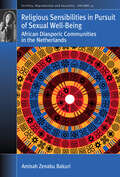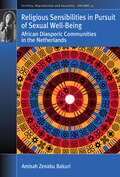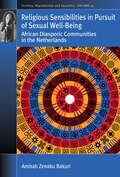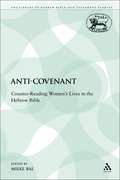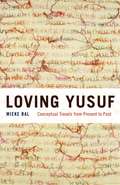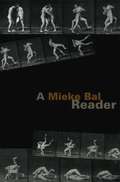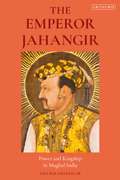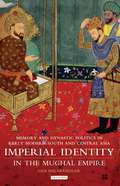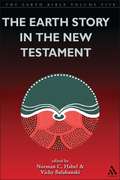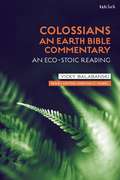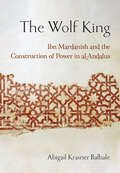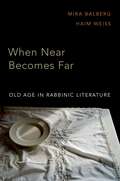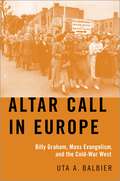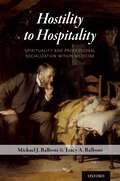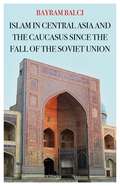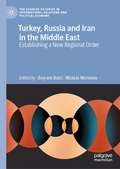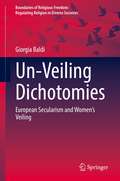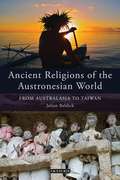- Table View
- List View
Religious Sensibilities in Pursuit of Sexual Well-Being: African Diasporic Communities in the Netherlands (Fertility, Reproduction and Sexuality: Social and Cultural Perspectives #55)
by Amisah Zenabu BakuriThe self-identifying Ghanaian-Dutch and Somali-Dutch communities residing in the Randstad area of the Netherlands are deeply impacted by religious beliefs and cultural factors in their approach towards sexual health practices, well-being and pleasure. This book shows how religious sensibilities shape the physical activities, beauty practices, and gendered roles that are adopted into the daily lives of these communities in pursuit of their sexual and general well-being. Through an ethnographic account, it explores and challenges the assumptions held around the complex relationship between religion and sexuality.
Religious Sensibilities in Pursuit of Sexual Well-Being: African Diasporic Communities in the Netherlands (Fertility, Reproduction and Sexuality: Social and Cultural Perspectives #55)
by Amisah Zenabu BakuriThe self-identifying Ghanaian-Dutch and Somali-Dutch communities residing in the Randstad area of the Netherlands are deeply impacted by religious beliefs and cultural factors in their approach towards sexual health practices, well-being and pleasure. This book shows how religious sensibilities shape the physical activities, beauty practices, and gendered roles that are adopted into the daily lives of these communities in pursuit of their sexual and general well-being. Through an ethnographic account, it explores and challenges the assumptions held around the complex relationship between religion and sexuality.
Religious Sensibilities in Pursuit of Sexual Well-Being: African Diasporic Communities in the Netherlands (Fertility, Reproduction and Sexuality: Social and Cultural Perspectives #55)
by Amisah Zenabu BakuriThe self-identifying Ghanaian-Dutch and Somali-Dutch communities residing in the Randstad area of the Netherlands are deeply impacted by religious beliefs and cultural factors in their approach towards sexual health practices, well-being and pleasure. This book shows how religious sensibilities shape the physical activities, beauty practices, and gendered roles that are adopted into the daily lives of these communities in pursuit of their sexual and general well-being. Through an ethnographic account, it explores and challenges the assumptions held around the complex relationship between religion and sexuality.
Anti-Covenant: Counter-Reading Women's Lives in the Hebrew Bible (The Library of Hebrew Bible/Old Testament Studies)
by Mieke BalThis collection of essays from feminist Biblical scholars including Carol Delaney, Rachel C. Rasmussen, Cynthia Baker and Mieke Bal, starts from the premise that reading is always in the plural. It is never just the text alone that is read, but also the scholarly meta-text. The essays encourage the reader to challenge his or her presuppositions that she has brought to an analysis of the Hebrew Bible, before returning the scrutiny to the text and using a narratological approach to investigate. This insight raises such questions as: who speaks? who sees? and who acts? This now familiar means of analysing texts has lost none of its power to demand answers otherwise not forthcoming. The essays provide a rigorous re- assessment of familiar stories of the Hebrew Bible and suggest we encourage the practice of a hermeneutics of suspicion.
Loving Yusuf: Conceptual Travels from Present to Past (Afterlives of the Bible)
by Mieke BalWhen Mieke Bal reread the story of Joseph and Potiphar’s wife as an adult, she was struck by differences between her childhood memories of a moral tale and what she read today. In Loving Yusuf¸ Bal seeks to resolve this clash between memory and text, using the same story, in which Joseph spurns the advance of his master’s wife who then falsely accuses him of rape, as her point of departure. She juxtaposes the Genesis tale to the rather different version told in the Qur’an and the depictions of it by Rembrandt and explores how Thomas Mann’s great retelling in Joseph and His Brothers reworks these versions. Through this inquiry she develops concepts for the analysis of texts that are both strange and overly familiar—culturally remote yet constantly retold. As she puts personal memories in dialogue with scholarly exegesis, Bal asks how all of these different versions complicate her own and others’ experience of the story, and how the different truths of these texts in their respective traditions illuminate the process of canonization.
Loving Yusuf: Conceptual Travels from Present to Past (Afterlives of the Bible)
by Mieke BalWhen Mieke Bal reread the story of Joseph and Potiphar’s wife as an adult, she was struck by differences between her childhood memories of a moral tale and what she read today. In Loving Yusuf¸ Bal seeks to resolve this clash between memory and text, using the same story, in which Joseph spurns the advance of his master’s wife who then falsely accuses him of rape, as her point of departure. She juxtaposes the Genesis tale to the rather different version told in the Qur’an and the depictions of it by Rembrandt and explores how Thomas Mann’s great retelling in Joseph and His Brothers reworks these versions. Through this inquiry she develops concepts for the analysis of texts that are both strange and overly familiar—culturally remote yet constantly retold. As she puts personal memories in dialogue with scholarly exegesis, Bal asks how all of these different versions complicate her own and others’ experience of the story, and how the different truths of these texts in their respective traditions illuminate the process of canonization.
Loving Yusuf: Conceptual Travels from Present to Past (Afterlives of the Bible)
by Mieke BalWhen Mieke Bal reread the story of Joseph and Potiphar’s wife as an adult, she was struck by differences between her childhood memories of a moral tale and what she read today. In Loving Yusuf¸ Bal seeks to resolve this clash between memory and text, using the same story, in which Joseph spurns the advance of his master’s wife who then falsely accuses him of rape, as her point of departure. She juxtaposes the Genesis tale to the rather different version told in the Qur’an and the depictions of it by Rembrandt and explores how Thomas Mann’s great retelling in Joseph and His Brothers reworks these versions. Through this inquiry she develops concepts for the analysis of texts that are both strange and overly familiar—culturally remote yet constantly retold. As she puts personal memories in dialogue with scholarly exegesis, Bal asks how all of these different versions complicate her own and others’ experience of the story, and how the different truths of these texts in their respective traditions illuminate the process of canonization.
A Mieke Bal Reader
by Mieke BalMieke Bal has had a significant impact on every field she has touched, from Old Testament scholarship and narratology to critical methods and visual culture. This brilliant and controversial intellectual invariably performs a high-wire act at the point where critical issues and methods intersect—or collide. She is deeply interested in the problems of cultural analysis across a range of disciplines. A Mieke Bal Reader brings together for the first time a representative collection of her work that distills her broad interests and areas of expertise. This Reader is organized into four parts, reflecting the fields that Bal has most profoundly influenced: literary study, interdisciplinary methodology, visual analysis, and postmodern theology. The essays include some of Bal’s most characteristic and provocative work, capturing her at the top of her form. “Narration and Focalization,” for example, provides the groundwork for Bal’s ideas on narrative, while “Reading Art?” clearly outlines her concept of reading images. “Religious Canon and Literary Identity” reenvisions Bal’s own work at the intersection of theology and cultural analysis, while “Enfolding Feminism” argues for a new feminist rallying cry that is not a position but a metaphor. More than a dozen other essays round out the four sections, each of which is interdisciplinary in its own right: the section devoted to literature, for instance, ranges widely over psychoanalysis, theology, photography, and even autobiography. A Mieke Bal Reader is the product of a capacious intellect and a sustained commitment to critical thinking. It will prove to be instructive, maddening, and groundbreaking—in short, all the hallmarks of intellectual inquiry at its best.
The Emperor Jahangir: Power and Kingship in Mughal India
by Lisa BalabanlilarJahangir was the fourth of the six “Great Mughals,” the oldest son of Akbar the Great, who extended the Mughal Empire across the Indian Subcontinent, and the father of Shah Jahan, builder of the Taj Mahal. Although an alcoholic and opium addict, his reputation marred by rebellion against his father, once enthroned the Emperor Jahangir proved to be an adept politician. He was also a thoughtful and reflective memoirist and a generous patron of the arts, responsible for an innovative golden age in Mughal painting. Through a close study of the seventeenth century Mughal court chronicles, The Emperor Jahangir sheds new light on this remarkable historical figure, exploring Jahangir's struggle for power and defense of kingship, his addictions and insecurities, his relationship with his favourite wife, the Empress Nur Jahan, and with his sons, whose own failed rebellions bookended his reign.
The Emperor Jahangir: Power and Kingship in Mughal India
by Lisa BalabanlilarJahangir was the fourth of the six “Great Mughals,” the oldest son of Akbar the Great, who extended the Mughal Empire across the Indian Subcontinent, and the father of Shah Jahan, builder of the Taj Mahal. Although an alcoholic and opium addict, his reputation marred by rebellion against his father, once enthroned the Emperor Jahangir proved to be an adept politician. He was also a thoughtful and reflective memoirist and a generous patron of the arts, responsible for an innovative golden age in Mughal painting. Through a close study of the seventeenth century Mughal court chronicles, The Emperor Jahangir sheds new light on this remarkable historical figure, exploring Jahangir's struggle for power and defense of kingship, his addictions and insecurities, his relationship with his favourite wife, the Empress Nur Jahan, and with his sons, whose own failed rebellions bookended his reign.
Imperial Identity in the Mughal Empire: Memory and Dynastic Politics in Early Modern South and Central Asia (Library of South Asian History and Culture)
by Lisa BalabanlilarHaving monopolized Central Asian politics and culture for over a century, the Timurid ruling elite was forced from its ancestral homeland in Transoxiana at the turn of the sixteenth century by an invading Uzbek tribal confederation. The Timurids travelled south: establishing themselves as the new rulers of a region roughly comprising modern Afghanistan, Pakistan and northern India, and founding what would become the Mughal Empire (1526-1857). The last survivors of the House of Timur, the Mughals drew invaluable political capital from their lineage, which was recognized for its charismatic genealogy and court culture - the features of which are examined here. By identifying Mughal loyalty to Turco-Mongol institutions and traditions, Lisa Balabanlilar here positions the Mughal dynasty at the centre of the early modern Islamic world as the direct successors of a powerful political and religious tradition.
The Earth Story in the New Testament: Volume 5
by Vicky Balabanski Norman C. HabelThe "Earth Bible" is an international project, including volumes on ecojustice readings of major sections of the Bible. The basic aims of the Earth Bible project are: to develop ecojustice principles appropriate to an Earth hermeneutic for interpreting the Bible and for promoting justice and healing for Earth; to publish these interpretations as contributions to the current debate on ecology, ecoethics and ecotheology; to provide a responsible forum within which the suppressed voice of Earth may be heard and impulses for healing Earth may be generated. The project explores text and tradition from the perspective of Earth, employing a set of ecojustice principles developed in consultation with ecologists, suspecting that the text and/or its interpreters may be anthropocentric and not geocentric, but searching to retrieve alternative traditions that hear the voice of Earth and value Earth as more than a human instrument. The lead article in Volume V is a reflection in responses to the ecojustice principles employed in the hermeneutic of the project. Several articles offer insights into New Testament texts that seem to devalue Earth in favour of heaven. The final article by Barbara Rossing challenges the popular apocalyptic notion that in the new age Earth will be terminated. A feature of this volume is a dialogue between Norman Habel, who argues that John One seems to devalue Earth, and two respondents, Elaine Wainwright and Vicky Balabanski (who is coeditor of this volume with Norman Habel). 1
Colossians: An Eco-Stoic Reading (Earth Bible Commentary)
by Victoria S. BalabanskiVictoria Balabanski analyses Colossians as a co-authored letter, writtenduring Paul's Roman imprisonment by Timothy with the input of Epaphras, and sent with Paul's introductory and concluding greetings. The Letter to the Colossians has the highest view of Christ of any of the New Testament writings, and this theology of divine permeation invites us to notice the ecological potential of this letter.Balabanksi explores how the cosmological background to this letter has remarkable resonances with Stoic thought, the most widely held philosophy in first century Asia Minor. Drawing upon how stoic thinkers sought to notice the way the divine Spirit permeated reality and to attune their lives to the Logos, divine reason, she argues that the Gospel of Christ was welcomed by small groups of people shaped by Stoic thought, and they experienced Christ as the visible expression of the One God who permeates reality.
Colossians: An Eco-Stoic Reading (Earth Bible Commentary)
by Victoria S. BalabanskiVictoria Balabanski analyses Colossians as a co-authored letter, writtenduring Paul's Roman imprisonment by Timothy with the input of Epaphras, and sent with Paul's introductory and concluding greetings. The Letter to the Colossians has the highest view of Christ of any of the New Testament writings, and this theology of divine permeation invites us to notice the ecological potential of this letter.Balabanksi explores how the cosmological background to this letter has remarkable resonances with Stoic thought, the most widely held philosophy in first century Asia Minor. Drawing upon how stoic thinkers sought to notice the way the divine Spirit permeated reality and to attune their lives to the Logos, divine reason, she argues that the Gospel of Christ was welcomed by small groups of people shaped by Stoic thought, and they experienced Christ as the visible expression of the One God who permeates reality.
The Wolf King: Ibn Mardanish and the Construction of Power in al-Andalus (Medieval Societies, Religions, and Cultures)
by Abigail Krasner BalbaleThe Wolf King explores how political power was conceptualized, constructed, and wielded in twelfth-century al-Andalus, focusing on the eventful reign of Muhammad ibn Sad ibn Ahmad ibn Mardanīsh (r. 1147–1172). Celebrated in Castilian and Latin sources as el rey lobo/rex lupus and denigrated by Almohad and later Arabic sources as irreligious and disloyal to fellow Muslims because he fought the Almohads and served as vassal to the Castilians, Ibn Mardanīsh ruled a kingdom that at its peak constituted nearly half of al-Andalus and served as an important buffer between the Almohads and the Christian kingdoms of Castile and Aragon.Through a close examination of contemporary sources across the region, Abigail Krasner Balbale shows that Ibn Mardanīsh's short-lived dynasty was actually an attempt to integrate al-Andalus more closely with the Islamic East—particularly the Abbasid caliphate. At stake in his battles against the Almohads was the very idea of the caliphate in this period, as well as who could define righteous religious authority. The Wolf King makes effective use of chronicles, chancery documents, poetry, architecture, coinage, and artifacts to uncover how Ibn Mardanīsh adapted language and cultural forms from around the Islamic world to assert and consolidate power—and then tracks how these strategies, and the memory of Ibn Mardanīsh more generally, influenced expressions of kingship in subsequent periods.
When Near Becomes Far: Old Age in Rabbinic Literature
by Mira Balberg Haim WeissWhen Near Becomes Far explores the representations and depictions of old age in the rabbinic Jewish literature of late antiquity (150-600 CE). Through close literary readings and cultural analysis, the book reveals the gaps and tensions between idealized images of old age on the one hand, and the psychologically, physiologically, and socially complicated realities of aging on the other hand. The authors argue that while rabbinic literature presents a number of prescriptions related to qualities and activities that make for good old age, the respect and reverence that the elderly should be awarded, and harmonious intergenerational relationship, it also includes multiple anecdotes and narratives that portray aging in much more nuanced and poignant ways. These anecdotes and narratives relate, alongside fantasies about blissful or unnoticeable aging, a host of fears associated with old age: from the loss of physical capability and beauty to the loss of memory and mental acuity, and from marginalization in the community to being experienced as a burden by one's children. Each chapter of the book focuses on a different aspect of aging in the rabbinic world: bodily appearance and sexuality, family relations, intellectual and cognitive prowess, honor and shame, and social roles and identity. As the book shows, in their powerful and sensitive treatments of aging, rabbinic texts offer some of the richest and most audacious observations on aging in ancient world literature, many of which still resonate today.
Altar Call in Europe: Billy Graham, Mass Evangelism, and the Cold-War West
by Uta A. BalbierBilly Graham's ministry is often described as a quintessentially American success story. However, by 1954, Billy Graham was bigger news in London than in Texas. Altar Call explores how Graham's encounters and perception in Europe shaped what was from the beginning on an international ministry. Graham was responsible for an unparalleled transformation of US evangelicalism in the second half of the twentieth century. He is also remembered as America's pastor-in-chief, having met with every US President since Harry S. Truman. But Graham's path to triumph was paved abroad. The revival meetings Graham held in London, Berlin, and New York in the 1950s provided lively fora for ministers, politicians, and ordinary Christians to imagine and experience the future of faith, the role of religion in the Cold War, and the intersections between faith and consumer culture in new ways. Graham challenged believers and religious leaders alike to re-position religion amidst the rise of consumerism, moral post-war regeneration, and cold-war tensions. At this confluence of anxieties and desires across the Atlantic, Graham's ministry revealed remarkably similar needs among the faithful and those yearning for renewal. It is the responses of Church leaders to this need, rather than inherent differences in religious sensitivities, that helps to explain the divergent paths to secularization between the US and its European allies, Germany and the UK.
Altar Call in Europe: Billy Graham, Mass Evangelism, and the Cold-War West
by Uta A. BalbierBilly Graham's ministry is often described as a quintessentially American success story. However, by 1954, Billy Graham was bigger news in London than in Texas. Altar Call explores how Graham's encounters and perception in Europe shaped what was from the beginning on an international ministry. Graham was responsible for an unparalleled transformation of US evangelicalism in the second half of the twentieth century. He is also remembered as America's pastor-in-chief, having met with every US President since Harry S. Truman. But Graham's path to triumph was paved abroad. The revival meetings Graham held in London, Berlin, and New York in the 1950s provided lively fora for ministers, politicians, and ordinary Christians to imagine and experience the future of faith, the role of religion in the Cold War, and the intersections between faith and consumer culture in new ways. Graham challenged believers and religious leaders alike to re-position religion amidst the rise of consumerism, moral post-war regeneration, and cold-war tensions. At this confluence of anxieties and desires across the Atlantic, Graham's ministry revealed remarkably similar needs among the faithful and those yearning for renewal. It is the responses of Church leaders to this need, rather than inherent differences in religious sensitivities, that helps to explain the divergent paths to secularization between the US and its European allies, Germany and the UK.
Hostility to Hospitality: Spirituality and Professional Socialization within Medicine
by Michael J. Balboni Tracy A. BalboniSpiritual sickness troubles American medicine. Through a death-denying culture, medicine has gained enormous power-an influence it maintains by distancing itself from religion, which too often reminds us of our mortality. As a result of this separation of medicine and religion, patients facing serious illness infrequently receive adequate spiritual care, despite the large body of empirical data demonstrating its import to patient meaning-making, quality of life, and medical utilization. This secular-sacred divide also unleashes depersonalizing, social forces through the market, technology, and legal-bureaucratic powers that reduce clinicians to tiny cogs in an unstoppable machine. Hostility to Hospitality is one of the first books of its kind to explore these hostilities threatening medicine and offer a path forward for the partnership of modern medicine and spirituality. Drawing from interdisciplinary scholarship including empirical studies, interviews, history and sociology, theology, and public policy, the authors argue for structural pluralism as the key to changing hostility to hospitality.
Hostility to Hospitality: Spirituality and Professional Socialization within Medicine
by Michael J. Balboni Tracy A. BalboniSpiritual sickness troubles American medicine. Through a death-denying culture, medicine has gained enormous power-an influence it maintains by distancing itself from religion, which too often reminds us of our mortality. As a result of this separation of medicine and religion, patients facing serious illness infrequently receive adequate spiritual care, despite the large body of empirical data demonstrating its import to patient meaning-making, quality of life, and medical utilization. This secular-sacred divide also unleashes depersonalizing, social forces through the market, technology, and legal-bureaucratic powers that reduce clinicians to tiny cogs in an unstoppable machine. Hostility to Hospitality is one of the first books of its kind to explore these hostilities threatening medicine and offer a path forward for the partnership of modern medicine and spirituality. Drawing from interdisciplinary scholarship including empirical studies, interviews, history and sociology, theology, and public policy, the authors argue for structural pluralism as the key to changing hostility to hospitality.
Islam in Central Asia and the Caucasus Since the Fall of the Soviet Union
by Bayram BalciWith the end of the Soviet Union in 1991, a major turning point in all former Soviet republics, Central Asian and Caucasian countries began to reflect on their history and identities. As a consequence of their opening up to the global exchange of ideas, various strains of Islam and trends in Islamic thought have nourished the Islamic revival that had already started in the context of glasnost and perestroika--from Turkey, Iran, the Arabian Peninsula, and from the Indian subcontinent; the four regions with strong ties to Central Asian and Caucasian Islam in the years before Soviet occupation. Bayram Balci seeks to analyse how these new Islamic influences have reached local societies and how they have interacted with pre-existing religious belief and practice. Combining exceptional erudition with rare first-hand research, Balci's book provides a sophisticated account of both the internal dynamics and external influences in the evolution of Islam in the region.
Islam in Central Asia and the Caucasus Since the Fall of the Soviet Union
by Bayram BalciWith the end of the Soviet Union in 1991, a major turning point in all former Soviet republics, Central Asian and Caucasian countries began to reflect on their history and identities. As a consequence of their opening up to the global exchange of ideas, various strains of Islam and trends in Islamic thought have nourished the Islamic revival that had already started in the context of glasnost and perestroika--from Turkey, Iran, the Arabian Peninsula, and from the Indian subcontinent; the four regions with strong ties to Central Asian and Caucasian Islam in the years before Soviet occupation. Bayram Balci seeks to analyse how these new Islamic influences have reached local societies and how they have interacted with pre-existing religious belief and practice. Combining exceptional erudition with rare first-hand research, Balci's book provides a sophisticated account of both the internal dynamics and external influences in the evolution of Islam in the region.
Turkey, Russia and Iran in the Middle East: Establishing a New Regional Order (The Sciences Po Series in International Relations and Political Economy)
by Bayram Balci Nicolas MonceauThis book explores the complexity of the Syrian question and its effects on the foreign policies of Russia, Iran, and Turkey. The Syrian crisis has had a major effect on the regional order in the Middle East. Syria has become a territory where the rivalry between Russia and Western powers is being played out, and with the West’s gradual withdrawal, the conflict will without a doubt have lasting effects locally and on the international order. This collection focuses on the effects of the Syrian crisis on the new governance of the Middle East region by three political regimes: Russia, Iran, and Turkey. Many articles and a number of books have been written on this conflict, which has lasted over ten years, but no publication has examined simultaneously and comparatively how these three states are participating in the shared management of the Syrian conflict.
Un-Veiling Dichotomies: European Secularism and Women’s Veiling (Boundaries of Religious Freedom: Regulating Religion in Diverse Societies)
by Giorgia BaldiThis book analyzes the implication of secular/liberal values in Western and human rights law and its impact on Muslim women. It offers an innovative reading of the tension between the religious and secular spheres. The author does not view the two as binary opposites. Rather, she believes they are twin categories that define specific forms of lives as well as a specific notion of womanhood. This divergence from the usual dichotomy opens the doors for a reinterpretation of secularism in contemporary Europe. This method also helps readers to view the study of religion vs. secularism in a new light. It allows for a better understanding of the challenges that contemporary Europe now faces regarding the accommodation of different religious identities. For instance, one entire section of the book concerns the practice of veiling and explores the contentious headscarf debate. It features case studies from Germany, France, and the UK. In addition, the analysis combines a wide range of disciplines and employs an integrated, comparative, and inter-disciplinary approach. The author successfully brings together arguments from different fields with a comparative legal and political analysis of Western and Islamic law and politics. This innovative study appeals to students and researchers while offering an important contribution to the debate over the role of religion in contemporary secular Europe and its impact on women’s rights and gender equality.
Ancient Religions of the Austronesian World: From Australasia to Taiwan (International Library of Ethnicity, Identity and Culture)
by Julian BaldickAustronesia is the vast oceanic region which stretches from Madagascar to Taiwan to New Zealand. Encompassing both scattered archipelagos and major landmasses, Austronesia – derived from the Latin australis, 'southern', and Greek nesos, 'island' – is used primarily as a linguistic term, designating a family of languages spoken by peoples with a shared heritage. Julian Baldick, a celebrated historian of ancient religion, here argues that the diverse inhabitants of the Philippines, Taiwan, Indonesia, New Guinea and Oceania show a common inheritance that extends beyond language. This commonality is found above all in mythology and ritual, which reach back to an ancient, prehistoric past. From around 1250 BCE the original proto-Oceanic speakers migrated eastwards from southeast Asia. Navigating by the sun, the stars, bird flight, the swells of the sea and cloud-swathed mountain islands, Austronesian voyagers used canoes and outriggers to settle on new territories. They developed a unified pattern of religion characterised by mortuary rites, headhunting and agrarian rituals of the annual calendar, culminating in a post-harvest festival often sexual in nature. This unique overview of Austronesian belief and tradition will be essential reading for students of religion, prehistory and anthropology.
